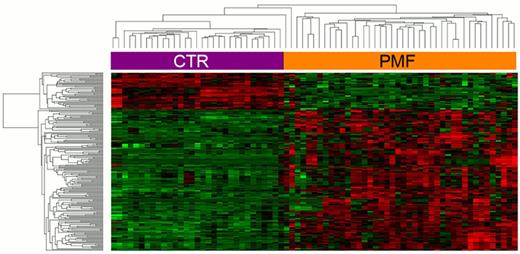Abstract
Abstract 2854
Molecular mechanisms underlying Philadephia-negative myeloproliferative neoplasm (MPN) pathogenesis were partially unraveled in 2005–2006 with the identification of somatic gain-of-function of JAK2 and MPL, after which many other mutated genes were found. Recently, several new molecular pathogenetic mechanisms were identified. Among them, aberrant microRNA (miRNA) expression especially seems to add to the molecular complexity of MPNs, as specific miRNA signatures capable of discriminating MPN cells from those of normal donors were previously reported (P. Guglielmelli et al., Exp Hematol, 2007). In order to have a comprehensive picture of miRNA deregulation and its relationship with differential gene expression in primary myelofibrosis (PMF) cells, we obtained coding gene- (GEP) and miRNA expression profiles (miEP) in the same CD34+ sample from 31 healthy donors and 42 PMF patients by means of Affymetrix technology (HG-U219 and miRNA 2.0 arrays). 726 genes were found as differentially expressed (DEG) (fold change contrast ≥2, false discovery rate ≤0.05) (FIG. 1) and further analysis pointed out that several DEG are related to processes involved in PMF progression as megakaryocyte (MK) differentiation, fibrosis and migration. Of interest, we found the upregulation of some putative cancer markers, such as WT1 (K. Inoue et al., Blood, 1994) and ANGPT1 (C.L. Cheng, Br J Cancer, 2011) whose expression has already been associated with poor prognosis in hematological neoplasms and in other malignancies.
Among the deregulated transcription factors, we detected several genes involved in CD34+ commitment, and potentially in their transformation, such as NFE-2 (C. LAbbaye et al., J Clin Invest, 1995) and KLF3 (A.P. Funnell, Mol Cell Biol, 2012). As regards miEP, we achieved a list of 74 human miRNAs modulated in PMF (DEM) (fold change contrast ≥1.5, false discovery rate ≤0.05), some of which associated with hematological malignancies or known as oncomirs are upregulated, i.e. hsa-miR-155-5p (S. Jiang, Cancer Res, 2010), miRNAs belonging to the miR-17–92 cluster (L. Venturini et al., Blood, 2007), whereas other aberrantly expressed miRNAs have never been described in any hematological context. Next, we performed an in silico integrative analysis (IA) with Ingenuity Pathway analysis software, which combines the computational predicted targets with the gene expression data, in order to construct regulatory networks of the functional human miRNA-target interactions. IA between DEG and DEM disclosed a high number of predicted targets with anti-correlated expression to the trend of their targeting miRNAs. This approach allowed the identification of different networks potentially involved in PMF onset and progression, such as MK differentiation and chromatin remodeling, highlighting the potential contribution of miRNAs to PMF pathogenesis.
In particular, the integrative analysis has identified an interaction network involving the oncomirs miR-155-5p and miR-29a-3p (R. M. O'Connel et al, J Exp Med, 2008, Y.C. Han et al, j Exp Med, 2010) and their targets (FIG. 2).
In this network the upregulation of miR-155-5p and mir-29a-3p could explain the negative regulation of two tumor suppressor genes, HBP1 and TP53INP1, and of SPTB1, CDC42 and KLF3, whose downregulation is involved in malignant hematopoiesis (L.Yang et al, Blood 2007). This network also shows the upregulation of some miRNAs whose function is unknown in the hematopoietic context as miR-335-5p, with the negative regulation of its predicted targets, NR4A3 and PRDM2, which are described as implicated in myeloproliferation (AM Ramirez-Herrick et al, Blood 2001).
The present findings lay the groundwork for functional in vitro validation of selected networks in normal and PMF CD34+ cells by means of DEG/DEM overexpression and silencing experiments; furthermore, expression data will be helpful in order to find a clinical correlation between mRNA/miRNA expression levels and diagnostic/prognostic relevance.
In conclusion, GEP and miEP pointed out genes and miRNAs candidate for elucidating some of the pathogenetic features of PMF CD34+ cells, whereas IA uncovered potential regulatory networks in which aberrantly expressed miRNAs and genes interact contributing to the malignant phenotype.
Vannucchi:Novartis: Membership on an entity's Board of Directors or advisory committees.
Author notes
Asterisk with author names denotes non-ASH members.



This feature is available to Subscribers Only
Sign In or Create an Account Close Modal